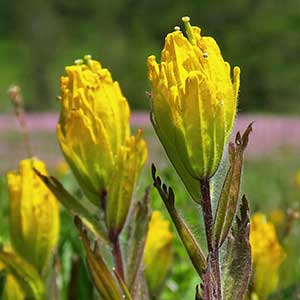Castilleja levisecta
Castilleja exserta
golden Indian paintbrush, golden paintbrush
castilleja exserta, escobita, exserted Indian paintbrush, owl's clover, purple owl's-clover, purple painted-cup
few to many, erect, ± decumbent or creeping at base, unbranched, sometimes branched, hairs spreading, medium length and long, soft, mixed with short stipitate-glandular ones.
solitary, erect to ascending, unbranched or diffusely branched from near base, hairs spreading, medium length and long, stiff, mixed with short stipitate-glandular ones.
green to purple or brown-tinged, linear-lanceolate proximally, oblong-ovate or -obovate distally, 0.8–5.2 cm, not fleshy, margins plane, distalmost sometimes ± wavy, involute, 3–7(–11)-lobed, apex obtuse;
lobes erect to ascending, linear to linear-spatulate, very short, toothlike, usually arising from distal 1/3 of blade, apex rounded.
green, sometimes purple to brownish, linear or ovate to orbicular in outline, (0.8–)1–5(–7.7) cm, not fleshy, margins plane, involute, (0–)3–9(–11)-lobed, sometimes with secondary lobing, apex acuminate to rounded or acute;
lobes spreading, filiform or linear to narrowly spatulate, apex acute to acuminate or rounded.
2.5–25 × 1–4 cm;
bracts bright yellow throughout, or proximally greenish, distally bright yellow, sometimes deep yellow-orange, especially with age, oblong, elliptic, or obtuse to ovate, (0–)5–9(–13)-lobed, sometimes wavy-margined;
lobes erect to ascending, oblong, short to medium length, arising above mid length, central lobe apex rounded, lateral ones rounded to acute.
1.5–20 × 2–4 cm;
bracts proximally greenish, dark purple, brownish purple, or white, distally pink, lavender, magenta, light purple, or white on lobe apices, lanceolate to elliptic or narrowly ovate, (3–)5(–9)-lobed, often with 2–4 secondary lobes;
lobes ascending to spreading, linear to filiform or narrowly spatulate, medium length to long, arising below or above mid length, apex rounded to acute.
straight or slightly curved, 17–28 mm;
tube 12–15 mm;
beak exserted, adaxially green or greenish yellow, 6–8 mm;
abaxial lip yellow or greenish, reduced, not inflated, 2–3 mm, 25–33(–50)% as long as beak;
teeth ascending to erect, yellow, 0.5–1.5 mm.
straight, 12–33 mm;
tube 7–20 mm;
beak slightly exserted, hooked near apex, adaxially pink-purple to magenta, rarely white, 5–13 mm, margins colored as bracts, densely villous-hairy;
abaxial lip proximally pink, purple, or magenta, rarely yellow or white, with maroon or deep purple distal to that and white to yellow or pink distally, often with purple spots, distal pale color often aging deep pink or deep red, strongly inflated, pouches 3, 3–8 mm wide, 3–4 mm deep, 3–9 mm, 67–80% as long as beak;
teeth erect, white, yellow, or purple, often with purple or maroon spots, 0.5–2 mm.
distally yellow, 13–22 mm;
abaxial and adaxial clefts 4–9.5 mm, 30–40% of calyx length, deeper than laterals, lateral 2.5–4.5 mm, ca. 25% of calyx length;
lobes linear to narrowly oblong or narrowly lanceolate, apex obtuse, sometimes rounded to acute.
colored as bracts, 10–26 mm;
abaxial clefts 4–12 mm, adaxial 9–18 mm, abaxial ca. 50% of calyx length, adaxial ca. 67% of calyx length, at least adaxial deeper than others, lateral 2.5–9 mm, 15–45% of calyx length;
lobes linear (to narrowly oblanceolate), apex rounded to acute.
with spreading, long, soft hairs.
= 24.
= 24.
Castilleja levisecta
Castilleja exserta
Castilleja levisecta is listed as threatened in the United States and endangered in Canada, where it is extremely rare. Most of its grassland habitat has been altered by development in the Puget Trough, and there are historical stations in the metro areas of what are now Victoria, Portland, and Seattle. For several decades, C. levisecta was considered extirpated from Oregon. However, recent reintroduction programs in Oregon and Washington have been very successful at reestablishing this species at several sites in the Willamette Valley. The bright yellow inflorescences often gradually age to a golden yellow color, unique in the genus.
Castilleja levisecta is in the Center for Plant Conservation’s National Collection of Endangered Plants.
(Discussion copyrighted by Flora of North America; reprinted with permission.)
Varieties 3 (3 in the flora).
In addition to the characters in the key, Castilleja exserta is distinguished from the similar C. densiflora by its conspicuously hairy and apically hooked beak. As a result, the capitate stigma is exserted more or less horizontally from the corolla beak. In contrast, C. densiflora has an unhooked, inconspicuously puberulent beak, from which the stigma emerges more vertically. Castilleja exserta hybridizes with C. attenuata in southern California and with C. lineariloba in central California, and it reportedly crosses occasionally with C. densiflora in southern California.
(Discussion copyrighted by Flora of North America; reprinted with permission.)
1. Abaxial lips of corollas deep red-purple proximally, with distal 1/4 bright yellow to yellow-orange, becoming orange or red after anthesis; w Mojave Desert, California. | var. venusta |
1. Abaxial lips of corollas variably colored, proximally pink to deep red-purple or white, with distal 1/4–1/3 white, yellow, or yellow-orange; widespread in Arizona and California, rare in New Mexico or limited to the coastal regions of California. | → 2 |
2. Bracts usually less than 5 mm wide, lobes filiform to linear; inland and near-coastal grasslands and meadows; Arizona, w California, sw New Mexico. | var. exserta |
2. Bracts 5–7 mm wide, lobes linear to narrowly spatulate; coastal dunes and bluffs; California. | var. latifolia |
- Local floras:
CA,
OR,
WA
- Local Web sites:
CalFlora,
CalPhotos,
Flora NW,
PNW Herbaria
WildflowerSearch
iNaturalist (observations)
USDA Plants Database
- LBJ Wildflower Center
- SEINet
- Plants of the World Online
- Encyclopedia of Life
- Wikipedia
- Google Image Search


